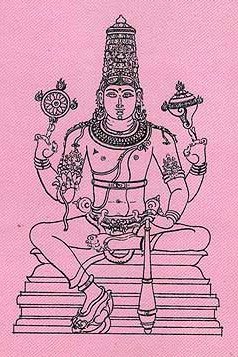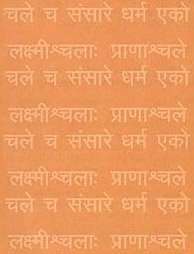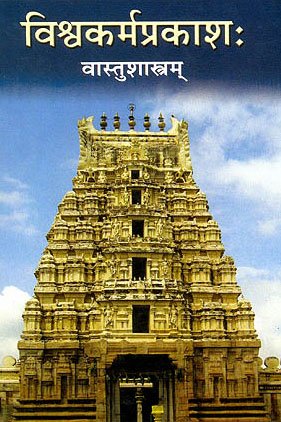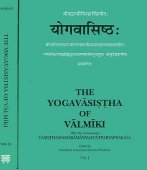Sthiti, Sthitī: 37 definitions
Introduction:
Sthiti means something in Buddhism, Pali, Hinduism, Sanskrit, Jainism, Prakrit, the history of ancient India, Marathi, Hindi. If you want to know the exact meaning, history, etymology or English translation of this term then check out the descriptions on this page. Add your comment or reference to a book if you want to contribute to this summary article.
Images (photo gallery)
In Hinduism
Pancaratra (worship of Nārāyaṇa)
Source: Wisdom Library: Lakṣmī-tantraSthiti (स्थिति, “the śakti of sustenance/integration”) is the third function of Nārāyaṇī (an epithet of Lakṣmī: Viṣṇu’s consort), according to the Lakṣmī-tantra (12.48-52). Through Lakṣmī’s ability to assume various forms, the function of sustaining that which exists in the period between the moment of creation and the moment my will to destroy (the creation) awakens, is called her supreme śakti of sthiti (integration.)
These are the four sthitis:
- Viṣṇu-sthiti,
- Manu-sthiti,
- Saptarṣi-sthiti,
- Kṣudra-sthiti.
Sthiti (स्थिति) refers to “Viṣṇu’s sustaining will”, as discussed in the tenth chapter of the Ahirbudhnyasaṃhitā, a Pāñcarātra work in 60 chapters dealing with topics such as Viṣṇu’s discus-power, the processes of creation and esoteric practices related to Sudarśana (such as mantras and yantras).—Description of the chapter [arthātmakapramāṇa-nirūpaṇa]: Nārada asks what proof there is for saying the entire world is sustained by a desire by Viṣṇu to uphold it, which desire is personified as His Sudarśana wheel symbol (1-6). Śiva undertakes to give the proof regarding Viṣṇu’s sthiti-sustaining will—in its collective (mahā-sthiti) regard (10) and in its individual-directed concern (vyaṣṭisthiti) (11-40a). [...]
Source: University of Vienna: Sudarśana's Worship at the Royal Court According to the AhirbudhnyasaṃhitāSthiti (स्थिति) means “to remain [abide]”, according to the Ahirbudhnyasaṃhitā, belonging to the Pāñcarātra tradition which deals with theology, rituals, iconography, narrative mythology and others.—Accordingly, “Lakṣmī does not dwell in the Brāhmaṇa alone, because of [his] excessive gentleness. Nor does She wish to remain (sthiti) in the Kṣatra alone (i.e. a member of the second social class to which also kings traditionally belong), being fearful of [his] excessive fierceness”.

Pancaratra (पाञ्चरात्र, pāñcarātra) represents a tradition of Hinduism where Narayana is revered and worshipped. Closeley related to Vaishnavism, the Pancaratra literature includes various Agamas and tantras incorporating many Vaishnava philosophies.
Purana and Itihasa (epic history)
Source: archive.org: Shiva Purana - English TranslationSthiti (स्थिति, “maintenance”) refers to the “maintenance of the world” and represents one of the “five-fold duties” (pañcakṛtya), according to Śivapurāna 1.10.1-5, “[...] the permanent cycle of the five-fold duties consists of creation, maintenance, annihilation, concealment, and blessing. [...] Sarga is the creation of the world. [...] These five are my activities but are carried on by others silently as in the case of the statue at the Portal. The first four activities concern the evolution of the world and the fifth one is the cause of salvation. All these constitute my prerogatives. These activities are observed in the five elements by devotees—[...] Sthiti (maintenance) in the waters [...] everything flourishes by virtue of the waters; [...] In order to look after these five-fold activities (pañcakṛtya) I have five faces, four in the four quarters and the fifth in the middle”.
Source: Cologne Digital Sanskrit Dictionaries: The Purana Index1a) Sthitī (स्थिती).—A Kalā of Brahmā.*
- * Brahmāṇḍa-purāṇa IV. 35. 94.
1b) A Kalā of Hari*
- * Brahmāṇḍa-purāṇa IV. 35. 95.
1c) An Ajitadeva.*
- * Vāyu-purāṇa 67. 33.

The Purana (पुराण, purāṇas) refers to Sanskrit literature preserving ancient India’s vast cultural history, including historical legends, religious ceremonies, various arts and sciences. The eighteen mahapuranas total over 400,000 shlokas (metrical couplets) and date to at least several centuries BCE.
Vyakarana (Sanskrit grammar)
Source: Wikisource: A dictionary of Sanskrit grammarSthiti (स्थिति).—Utterance of a pada or padas in the Padapatha without इति (iti); the utterance with इति (iti) being called उपस्थिति (upasthiti); cf. पदं यदा केवलमाह सा स्थितिः (padaṃ yadā kevalamāha sā sthitiḥ) R. Pr. XI.15; (2) established practice or view; cf. शाकल्यस्य स्थविरस्येतरा स्थितिः । (śākalyasya sthavirasyetarā sthitiḥ |) R. Pr. II. 44.

Vyakarana (व्याकरण, vyākaraṇa) refers to Sanskrit grammar and represents one of the six additional sciences (vedanga) to be studied along with the Vedas. Vyakarana concerns itself with the rules of Sanskrit grammar and linguistic analysis in order to establish the correct context of words and sentences.
Ayurveda (science of life)
Nighantu (Synonyms and Characteristics of Drugs and technical terms)
Source: Wisdom Library: Raj NighantuSthiti (स्थिति) is a synonym for Deśa (“region”), according to the second chapter (dharaṇyādi-varga) of the 13th-century Raj Nighantu or Rājanighaṇṭu (an Ayurvedic encyclopedia). The Dharaṇyādi-varga covers the lands [viz., Sthiti], soil, mountains, jungles and vegetation’s relations between trees and plants and substances, with their various kinds.

Āyurveda (आयुर्वेद, ayurveda) is a branch of Indian science dealing with medicine, herbalism, taxology, anatomy, surgery, alchemy and related topics. Traditional practice of Āyurveda in ancient India dates back to at least the first millenium BC. Literature is commonly written in Sanskrit using various poetic metres.
Shaktism (Shakta philosophy)
Source: Google Books: Manthanabhairavatantram1) Sthiti (स्थिति) refers to “persistence”, according to the second recension of the Yogakhaṇḍa of the Manthānabhairavatantra, a vast sprawling work that belongs to a corpus of Tantric texts concerned with the worship of the goddess Kubjikā.—Accordingly, as the Goddess said: “[...] That great power (mahat) is Viṣṇu and (its) form is energy (śaktibimba) that abides threefold. [...] Satisfaction (of all desires is attained) by means of that nectar and there is no rebirth. I am she who is threefold as emanation, persistence and withdrawal [i.e., sṛṣṭi-sthiti-laya-ātmikā]. I pervade the entire universe and the four types of living beings. Why do you praise (me)? Why do you meditate on me? Who else apart from me has authority? Who are you (heralded thus) with hymns and words (of praise)?”.
2) Sthiti (स्थिति) refers to the “abiding condition” (of the energy of consciousness), according to the Mahānayaprakāśa verse 2.1-35, while explaining the cycles of the goddesses of consciousness.—Accordingly, “This (energy) is the Primordial Sacrifice, the (most) noble and profound plane (of reality). It is intent towards the plane of repose within one’s own nature, which is hard to grasp and free of obscuration. It is the wine of Kula (i.e. immanence) and Akula (transcendence) consisting of the flow of the Great Resonance (of consciousness), which is internal and full. It is the abiding condition [i.e., sthiti] (of the energy of consciousness) as the unity brought about by the purification of objectivity and the latent traces (of the previous phases) when (all) is being destroyed with great force in order to perform the supreme lustration. Thus the most excellent teachers consider (this Sacrifice) to be Raudraraudreśvarī. [...]”.
Source: Brill: Śaivism and the Tantric Traditions (shaktism)Sthiti (स्थिति) refers to “residing (in a particular place)”, according to Sāhib Kaul’s Śārikāstrotra.—Accordingly, “[...] My mind does not strive after the divine state, just as a woman giving birth never craves enjoyment. Having gained perfect devotion to you it sings like a peacock who has heard the sound of the rain clouds. There is no place where you do not reside (sthiti); there is no voice in which you are not expressed. There is no word in which you are not heard; there is no thing in which you do not shine. [...]”.

Shakta (शाक्त, śākta) or Shaktism (śāktism) represents a tradition of Hinduism where the Goddess (Devi) is revered and worshipped. Shakta literature includes a range of scriptures, including various Agamas and Tantras, although its roots may be traced back to the Vedas.
Vedanta (school of philosophy)
Source: Wikisource: Ashtavakra GitaSthiti (स्थिति) refers to “dwelling place”, as mentioned in the Aṣṭāvakragītā 2.16ff.—Accordingly, “[...] Truly dualism is the root of suffering. There is no other remedy for it than the realization that all this that we see is unreal, and that I am the one stainless reality, consisting of consciousness. I am pure awareness though through ignorance I have imagined myself to have additional attributes. By continually reflecting like this, my dwelling place is in the Unimagined [i.e., nirvikalpa]. [...]”.

Vedanta (वेदान्त, vedānta) refers to a school of orthodox Hindu philosophy (astika), drawing its subject-matter from the Upanishads. There are a number of sub-schools of Vedanta, however all of them expound on the basic teaching of the ultimate reality (brahman) and liberation (moksha) of the individual soul (atman).
Jyotisha (astronomy and astrology)
Source: Wisdom Library: Brihat Samhita by VarahamihiraSthiti (स्थिति) refers to the “duration of the eclipse”, according to the Bṛhatsaṃhitā (chapter 2), an encyclopedic Sanskrit work written by Varāhamihira mainly focusing on the science of ancient Indian astronomy astronomy (Jyotiṣa).—Accordingly, “We shall now proceed to give a brief description of (the qualifications of) a jyotiṣaka. [...] In solar and lunar eclipses, he must be able to calculate the times of the commencement and end of the eclipses, the places of first and last contact, the magnitude and duration of the eclipse [i.e., sthiti]; in total eclipses, he must be able to calculate the time between middle eclipse and the beginning or end of total phase, (this period being technically known as vimarda). He must also know the colour of the eclipsed lunar disc. He must be able to calculate before hand the times of the Moon’s conjunction with the planets as well as of planetary conjunctions”.

Jyotisha (ज्योतिष, jyotiṣa or jyotish) refers to ‘astronomy’ or “Vedic astrology” and represents the fifth of the six Vedangas (additional sciences to be studied along with the Vedas). Jyotisha concerns itself with the study and prediction of the movements of celestial bodies, in order to calculate the auspicious time for rituals and ceremonies.
Shaivism (Shaiva philosophy)
Source: Brill: Śaivism and the Tantric TraditionsSthiti (स्थिति) refers to the “established practice (i.e. the Brahmanical order)”, according to the Jayadrathayāmala, Ṣaṭka 1 verse 13.3–18::—Accordingly, “[...] The lokadharmadīkṣā is a Śaiva ritual [and therefore] proceeds contrary to established [practice] (sthiti-viloma) (i.e. the Brahmanical order), but also conforms to worldly religion. Either [the Ācārya] should purify all [karma] or only not purify the dharma (i.e. the auspicious karma); [then the initiate] is dedicated to [the accumulation of] dharma through mundane observances, and having enjoyed this [dharma] he proceeds to liberation. [...]”.

Shaiva (शैव, śaiva) or Shaivism (śaivism) represents a tradition of Hinduism worshiping Shiva as the supreme being. Closely related to Shaktism, Shaiva literature includes a range of scriptures, including Tantras, while the root of this tradition may be traced back to the ancient Vedas.
Vastushastra (architecture)
Source: Brill: Śaivism and the Tantric Traditions (architecture)Sthiti (स्थिति) refers to a “place (where ascetics can reside)”, according to the Mohacūrottara (verse 4.234-243).—Accordingly, [while describing the construction of the maṭha]—“And a maṭha for ascetics to stay in (sthiti—liṅgināṃ sthitaye) should be in the south. For they, as devotees of Śiva, should reside to the right [of Śiva]. One should build a wall at a distance 1 temple-width beyond the temple base. At a distance from there is the housing for ascetics. [...]”.

Vastushastra (वास्तुशास्त्र, vāstuśāstra) refers to the ancient Indian science (shastra) of architecture (vastu), dealing with topics such architecture, sculpture, town-building, fort building and various other constructions. Vastu also deals with the philosophy of the architectural relation with the cosmic universe.
Yoga (school of philosophy)
Source: ORA: Amanaska (king of all yogas): A Critical Edition and Annotated Translation by Jason Birch1) Sthiti (स्थिति) refers to “stability (of mind)”, according to the Pātañjalayogaśāstra (i.e., the Yoga Sūtras of Patañjali) 1.34.—Accordingly, while discussing Prāṇāyāma and Samādhi: “Or [stability of mind is attained] through exhalation and retention of the breath”.—[Commentary]—“Exhalation is the emission of the abdominal breath through the nostrils with particular care, and retention is stopping the breath. Through both [of these], one should accomplish stability of mind (sthiti—manasaḥ sthitiṃ sampādayet)”.
2) Sthiti (स्थिति) refers to “preservation”, according to verse 10.16 of Sureśvarācārya’s Mānasollāsa.—Accordingly, “By merely his own will, [the Yogin] is the agent of creation, preservation (sthiti) and destruction of worlds [lokānāṃ sṛṣṭisthityantakartṛtā] and the master of the sun and so on. This is called [the Siddhi of] sovereignty”.

Yoga is originally considered a branch of Hindu philosophy (astika), but both ancient and modern Yoga combine the physical, mental and spiritual. Yoga teaches various physical techniques also known as āsanas (postures), used for various purposes (eg., meditation, contemplation, relaxation).
Sports, Arts and Entertainment (wordly enjoyments)
Source: archive.org: Syainika Sastra of Rudradeva with English Translation (art)Sthiti (स्थिति) refers to a “rule of propriety” (of the art of hunting), according to the Śyainika-śāstra: a Sanskrit treatise dealing with the divisions and benefits of Hunting and Hawking, written by Rājā Rudradeva (or Candradeva) in possibly the 13th century.—Accordingly, [while discussing the outlines of hawking]: “[...] One who has many hawks and many horsemen should make many circles, separated from each other. The hawker who stands at the middle of the circle in which the king is, should not, without his order, throw the hawk, even thongh the quarry may be very near. This is a rule of propriety which should never be broken (askhalita-sthiti). [...]”.

This section covers the skills and profiencies of the Kalas (“performing arts”) and Shastras (“sciences”) involving ancient Indian traditions of sports, games, arts, entertainment, love-making and other means of wordly enjoyments. Traditionally these topics were dealt with in Sanskrit treatises explaing the philosophy and the justification of enjoying the pleasures of the senses.
Shaiva philosophy
Source: Google Books: The philosophy of the PratyabhijñāSthiti (स्थिति) refers to the “cosmic operation of maintenance”, according to Abhinavagupta’s Īśvarapratyabhijñāvimarśinī (also known as the “doctrine of divine recognition”) with the Sanskrit commentary called Bhāskarī.—Accordingly, [Vol. I, p. 261-262] [automatically translated from the French]: “During the worldly activity, the Lord creates unity with this or that subject, destroys unity with [such] other subject, carries out [the cosmic operation of] maintenance (sthiti) with respect to that which consists of a simple [object] such as the pot, etc., imposes obscuration by obliterating its complete nature, [and] produces grace by conferring completeness by the manifestation of unity in this particular manifestation. Therefore, the Lord exercises the five [cosmic] activities (kṛtyapañcaka) not only in the great creations, the great maintenances (mahāsthiti), the great destructions, the obscurations due to [his] anger and the graces [granted on the occasion of] initiation, knowledge, etc., but still absolutely always, even in worldly activity”.
-
In Buddhism
Mahayana (major branch of Buddhism)
Source: Wisdom Library: Maha Prajnaparamita SastraSthiti (स्थिति) [=Sthitika?] refers to “duration”, according to Mahāprajñāpāramitāśāstra (chapter 41).—Accordingly, “[According to the Sarvāstivādin].—[...] Thus, the fire that was extinguished yesterday can today give rise to a memory, but it is impossible that this fire be revived by virtue of this memory. If I see that someone is gathering kindling (indhana), I know that they will light the fire and I say to myself that today’s fire is like yesterday’s fire, but it is not possible for the fire to be re-kindled by virtue of this memory that I have of the fire. It is the same for that which is things of the future. Although the present mind (pratyutpanna-citta) is instantaneous (kṣaṇika) and without duration (asthitika), it re-arises in series (saṃtāna) and is able to recognize dharmas. [...]”.
Source: academia.edu: A Study and Translation of the GaganagañjaparipṛcchāSthiti (स्थिति) refers to “abiding” (i.e., as in ‘arising and abiding’), according to the Gaganagañjaparipṛcchā: the eighth chapter of the Mahāsaṃnipāta (a collection of Mahāyāna Buddhist Sūtras).—Accordingly, “Son of good family, there are eight patiences reflecting on the dharma of the Bodhisattvas. What are the eight? [...] the patience without birth since characters are unconditioned; (6) the patience without origination (anutpāda) since there is no arising and abiding (utpāda-sthiti); (7) the patience without being since there is no destruction of things; (8) patience truly as it is since there is no destruction by time. Son of good family, those eight are the patiences reflecting on the dharma of the Bodhisattvas”.

Mahayana (महायान, mahāyāna) is a major branch of Buddhism focusing on the path of a Bodhisattva (spiritual aspirants/ enlightened beings). Extant literature is vast and primarely composed in the Sanskrit language. There are many sūtras of which some of the earliest are the various Prajñāpāramitā sūtras.
General definition (in Buddhism)
Source: Wisdom Library: Dharma-samgrahaSthiti (स्थिति, “stability”) refers to one of the thirteen “conditions” (saṃskāra) that are “unassociated with mind” (citta-viprayukta) as defined in the Dharma-saṃgraha (section 30). The Dharma-samgraha (Dharmasangraha) is an extensive glossary of Buddhist technical terms in Sanskrit (e.g., sthiti). The work is attributed to Nagarjuna who lived around the 2nd century A.D.
In Jainism
General definition (in Jainism)
Source: Encyclopedia of Jainism: Tattvartha SutraSthiti (स्थिति, “duration”).—What is meant by ‘duration’ (sthiti)? Time period during which the entity exists is called duration. according to the 2nd-century Tattvārthasūtra 1.7, “(Knowledge of the seven categories is attained) by definition, ownership, cause, location /resting place (substratum), duration and varieties/division”.
Source: Encyclopedia of Jainism: Tattvartha Sutra 3: The Lower and middle worldsSthiti (स्थिति, “state”).—How many types of state (sthiti) are there? Sthiti is of two types namely that of existence (bhava) and of body (kāya). What is meant by state of existence (bhava)? It is the time taken to exist in one mode (paryāya). What is meant by state of the body (kāya)? To be born again and again in the same body from (one mode to another) is called state of the body.
Source: Encyclopedia of Jainism: Tattvartha Sutra 8: Bondage of karmasSthiti (स्थिति, “duration”) or Sthitibandha refers to one of the four kinds of bondage (bandha) according to the 2nd-century Tattvārthasūtra chapter 8.—Accordingly, “what is meant by duration of bondage (sthiti-bandha)? Time period for which various species of karmas will stay bonded with the soul is called duration of the bondage”.
Source: The University of Sydney: A study of the Twelve ReflectionsSthiti (स्थिति) refers to “(having the) shape” (of a palm tree), according to the 11th century Jñānārṇava, a treatise on Jain Yoga in roughly 2200 Sanskrit verses composed by Śubhacandra.—Accordingly, “The cosmos is the shape of a palm tree (tālataru-sthiti) filled with the three worlds, surrounded by the three winds having great speed [and] great power in between [the cosmos and non-cosmos]. That [cosmos] is not at all produced by anyone, not at all sustained by anyone, so also not destroyed by anyone. Nevertheless, that exists by itself without support in the atmosphere”.

Jainism is an Indian religion of Dharma whose doctrine revolves around harmlessness (ahimsa) towards every living being. The two major branches (Digambara and Svetambara) of Jainism stimulate self-control (or, shramana, ‘self-reliance’) and spiritual development through a path of peace for the soul to progess to the ultimate goal.
India history and geography
Source: Cologne Digital Sanskrit Dictionaries: Indian Epigraphical GlossarySthiti.—(EI 32), decree. (IE 8-5), regulation; see ācāra-sthiti. (EI 12), usage; pratice [in respect of calculation of dates]; Mālava-gaṇa-sthiti-vāśāt=kāla-jñānāya likhiteṣu, ‘[in the years…] written for the knowledge of time (i. e. the date of some event) according to the practice [of calculation] of the Mālava republic’; Mālavānāṃ gaṇa-sthityā yāte śata-catuṣ- ṭaye, ‘four hundred years…having elapsed according to the practice [of calculation] of the Mālavas.” Note: sthiti is defined in the “Indian epigraphical glossary” as it can be found on ancient inscriptions commonly written in Sanskrit, Prakrit or Dravidian languages.

The history of India traces the identification of countries, villages, towns and other regions of India, as well as mythology, zoology, royal dynasties, rulers, tribes, local festivities and traditions and regional languages. Ancient India enjoyed religious freedom and encourages the path of Dharma, a concept common to Buddhism, Hinduism, and Jainism.
Languages of India and abroad
Marathi-English dictionary
Source: DDSA: The Molesworth Marathi and English Dictionarysthiti (स्थिति).—f (S) Stay, stand, rest; continuance, endurance; residence, inherence; state, condition; situation, site, position, posture &c.; stationedness or the standing or being (of any thing in any place). 2 One of the three states through which the universe or system of created things and every individual thing passes, viz. continuance or being. The three are utpatti, sthiti, laya or saṃhāra Arising into being; continuing in being; ceasing to be; or Birth or production; life or existence; death or destruction. And these are referred respectively, as their efficients, to brahmā, viṣṇu, śiva. 3 fig. Steadiness or stability (in the path of rectitude, in a determination, an undertaking &c.); stanchness, firmness, perseverance &c. 4 In astronomy. Duration of an eclipse. sthiti ōḷakhaṇēṃ To know one's place or position. sthitīvara (yēṇēṃ or asaṇēṃ) To come into, or be in, at, on &c. the right state, place, condition &c.
Source: DDSA: The Aryabhusan school dictionary, Marathi-Englishsthiti (स्थिति).—f Stay, situation. State. Fig. Steadiness. sthiti ōḷakhaṇēṃ Know one's place or position. sthitīvara (yēṇēṃ or asaṇēṃ) Come into, or be in, at, on, &c., the right place, state, &c.
Marathi is an Indo-European language having over 70 million native speakers people in (predominantly) Maharashtra India. Marathi, like many other Indo-Aryan languages, evolved from early forms of Prakrit, which itself is a subset of Sanskrit, one of the most ancient languages of the world.
Sanskrit dictionary
Source: DDSA: The practical Sanskrit-English dictionarySthiti (स्थिति).—f. [sthā-ktin]
1) Standing, remaining, staying, abiding, living, stay, residence; स्थितिं नो र दध्याः क्षणमपि मदान्धेक्षण सखे (sthitiṃ no ra dadhyāḥ kṣaṇamapi madāndhekṣaṇa sakhe) Bv.1.52; रक्षोगृहे स्थितिर्मूलमग्निशुद्धौ त्वनिश्चयः (rakṣogṛhe sthitirmūlamagniśuddhau tvaniścayaḥ) Uttararāmacarita 1.6.
2) Stopping, standing still, continuance in one state; प्रस्थितायां प्रतिष्ठेथाः स्थितायां स्थितिमाचरेः (prasthitāyāṃ pratiṣṭhethāḥ sthitāyāṃ sthitimācareḥ) R.1.89.
3) Remaining stationary, fixity, steadiness, firmness, steady application or devotion; मम भूयात् परमात्मनि स्थितिः (mama bhūyāt paramātmani sthitiḥ) Bv.4.23; Mālatīmādhava (Bombay) 5.22.
4) A state, position, situation, condition; एषा ब्राह्मी स्थितिः पार्थ नैनां प्राप्य विमुह्यति (eṣā brāhmī sthitiḥ pārtha naināṃ prāpya vimuhyati) Bhagavadgītā (Bombay) 2.72.
5) Natural state, nature, habit; सपर्वतावनां कृत्स्नां व्यथयिष्यामि ते स्थितिम् (saparvatāvanāṃ kṛtsnāṃ vyathayiṣyāmi te sthitim) Rām.7.98.1; अथ वा स्थितिरियं मन्दमतीनाम् (atha vā sthitiriyaṃ mandamatīnām) H.4.
6) Stability, permanence, perpetuation, continuance; वंशस्थितेरधिगमान्महति प्रमोदे (vaṃśasthiteradhigamānmahati pramode) V.5.15; कन्यां कुलस्य स्थितये स्थितिज्ञः (kanyāṃ kulasya sthitaye sthitijñaḥ) Kumārasambhava 1.18; Mv.7.3; R.3.27.
7) Correctness of conduct, steadfastness in the path of duty, decorum, duty, moral rectitude, propriety; अमंस्त चानेन परार्ध्यजन्मना स्थितेरभेत्ता स्थितिमन्तमन्वयम् (amaṃsta cānena parārdhyajanmanā sthiterabhettā sthitimantamanvayam) R.3.27;11.65;12.31; कन्यां कुलस्य स्थितये स्थितिज्ञः (kanyāṃ kulasya sthitaye sthitijñaḥ) (vidhinopayeme) Kumārasambhava 1.18; Ś.5.1.
8) Maintenance of discipline, establishment of good order (in a state); स्थित्यै दण्डयतो दण्ड्यान् (sthityai daṇḍayato daṇḍyān) R.1.25.
9) Rank, dignity, high station or rank.
1) Maintenance, sustenance; जग्धार्धैर्नवसल्लकीकिसलयैरस्याः स्थितिं कल्पयन् (jagdhārdhairnavasallakīkisalayairasyāḥ sthitiṃ kalpayan) Mālatīmādhava (Bombay) 9.32; R.5.9.
11) Continuance in life, preservation (one of the three states of human beings); सर्गस्थितिप्रत्यवहारहेतुः (sargasthitipratyavahārahetuḥ) R.2.44; Kumārasambhava 2.6.
12) Cessation, pause, stop, restriction; नासां कश्चिदगम्योस्ति नासां च वयसि स्थितिः (nāsāṃ kaścidagamyosti nāsāṃ ca vayasi sthitiḥ) Pañcatantra (Bombay) 1.143.
13) Wellbeing, welfare.
14) Consistency.
15) A settled rule, ordinance, decree, an axiom or maxim; अबान्धवं शवं चैव निर्हरेयुरिति स्थितिः (abāndhavaṃ śavaṃ caiva nirhareyuriti sthitiḥ) Manusmṛti 1.55.
16) Settled determination.
17) Term, limit, boundary.
18) Inertia, resistance to motion.
19) Duration of an eclipse.
2) Regard, consideration, account; नासां च वयसि स्थितिः (nāsāṃ ca vayasi sthitiḥ) Pañcatantra (Bombay) 1.143.
Derivable forms: sthitiḥ (स्थितिः).
Source: Cologne Digital Sanskrit Dictionaries: Shabda-Sagara Sanskrit-English DictionarySthiti (स्थिति).—f.
(-tiḥ) 1. Stay, staying, being fixed or stationary. 2. Correctness of conduct, continuance in the path of duty. 3. Limit, boundary, term. 4. Stop, cessation, pause. 5. Determination, order, decree. 6. Honour, dignity. 7. Duration of an eclipse, (in astronomy.) 8. Stay, residence. 9. Continuance in one state, stopping. 10. Any situation, state, position. 11. Natural state, habit. 12. Good condition, welfare. 13. High station, rank. 14. Consistency. 15. Establishment of good order, (in a government.) 16. Settled rule, axiom, maxim. 17. Inertia, resistance to motion, (in phil.) 18. One of the three states through which the system of created things has to pass, viz.:—that of preservation. E. ṣṭhā to stay or stand, aff. ktin .
Source: Cologne Digital Sanskrit Dictionaries: Benfey Sanskrit-English DictionarySthiti (स्थिति).—i. e. sthā + ti, f. 1. Standing, [Mālatīmādhava, (ed. Calc.)] 160, 6; staying, stay, [Mānavadharmaśāstra] 11, 237. 2. Living, doing well, Böhtl. Ind. Spr. 1125. 3. Residence, [Uttara Rāmacarita, 2. ed. Calc., 1862.] 5, 1. 4. Remaining, [Pañcatantra] pr. [distich] 8 (garbhe, in the womb, i. e. not being brought forth). 5. Keeping, i. [distich] 159 (but cf. v. r. Böhtl. Ind. Spr. 1561). 6. Being fixed, duration, [Vikramorvaśī, (ed. Bollensen.)] [distich] 153; a firm position, [Pañcatantra] i. [distich] 220. 7. State, [Cāṇakya] 90 in Berl. Monatsb. 1864, 412; condition, [Pañcatantra] 124, 4; natural state (cf. -sthāpaka, Bhāṣāp. 95, properly ‘restoring the natural state’). 8. Correctness of conduct, [Kirātārjunīya] 11, 54. 9. Honour, [Mālatīmādhava, (ed. Calc.)] 152, 20; dignity, [Nala] 12, 10. 10. Stop, cessation. 11. Limit, boundary. 12. A sure decision, [Mānavadharmaśāstra] 2, 225; a settled rule, 3, 120; a maxim, [Hitopadeśa] 50, 9, M. M. 13. Order, decree.
— [Pagê81-a+ 44] Comp. A-bhinna- (vb. bhid), adj. not swerving from the right path, [Śākuntala, (ed. Böhtlingk.)] [distich] 107. Pṛthak-, f. separation, [Vikramorvaśī, (ed. Bollensen.)] [distich] 102. Maṭha-, f. staying in a college of priests, [Pañcatantra] ii. [distich] 66 (read maṭhasthityā). Rājya-, f. staying in government, being a king, [Pañcatantra] 251, 9. Su-, f. 1. welfare. 2. health.
Source: Cologne Digital Sanskrit Dictionaries: Cappeller Sanskrit-English DictionarySthiti (स्थिति).—[feminine] standing, stopping, staying, remaining in or with ([locative] or —°); abode, place; situation, rank, dignity; devotion to or occupation with ([locative]); stability, duration; firmness, constancy, existence, occurrence; state, condition; conduct, procedure; axiom, maxime, rule, custom, usage, boundary, limit; rectitude, virtue.
Source: Cologne Digital Sanskrit Dictionaries: Monier-Williams Sanskrit-English Dictionary1) Sthiti (स्थिति):—[from sthā] f. standing upright or firmly, not falling, [Kāvyādarśa]
2) [v.s. ...] standing, staying, remaining, abiding, stay, residence, sojourn in or on or at ([locative case] or [compound]; sthitiṃ-√kṛ or vi- √1. dhā or √grah or √bhaj, ‘to make a stay’, ‘take up one’s abode’), [Kāvya literature; Kathāsaritsāgara] etc.
3) [v.s. ...] staying or remaining or being in any state or condition (See rājya-sth)
4) [v.s. ...] continuance in being, maintenance of life, continued existence (the 2nd of the three states of all created things, the 1st being utpatti, ‘coming into existence’, and the 3rd laya, ‘dissolution’), permanence, duration, [Śvetāśvatara-upaniṣad; Rāmāyaṇa; Kālidāsa; Bhāgavata-purāṇa; Sarvadarśana-saṃgraha]
5) [v.s. ...] duration of life, [Mārkaṇḍeya-purāṇa]
6) [v.s. ...] (in [astronomy]) duration of an eclipse, [Sūryasiddhānta]
7) [v.s. ...] continued existence in any place, [Mahābhārata; Sāhitya-darpaṇa]
8) [v.s. ...] that which continually exists, the world, earth, [Bhāgavata-purāṇa]
9) [v.s. ...] any situation or state or position or abode, [Kāvya literature; Pañcatantra; Kathāsaritsāgara]
10) [v.s. ...] station, high position, rank, [Manu-smṛti; Yājñavalkya; Bhagavad-gītā] etc.
11) [v.s. ...] maintenance, sustenance, [Mālatīmādhava]
12) [v.s. ...] settled rule, fixed decision, ordinance, decree, axiom, maxim, [Śatapatha-brāhmaṇa] etc. etc.
13) [v.s. ...] maintenance of discipline, establishment of good order (in a state etc.), [Raghuvaṃśa]
14) [v.s. ...] continuance or steadfastness in the path of duty, virtuous conduct, steadiness, rectitude, propriety, [Mahābhārata; Rāmāyaṇa; Raghuvaṃśa]
15) [v.s. ...] constancy, perseverance, [Bhagavad-gītā; Sarvadarśana-saṃgraha]
16) [v.s. ...] devotion or addiction to, intentness on ([locative case]), [Mahābhārata; Rāmāyaṇa]
17) [v.s. ...] firm persuasion or opinion, conviction, [Yājñavalkya; Kāmandakīya-nītisāra]
18) [v.s. ...] settled practice, institution, custom, usage, [Kathāsaritsāgara; Rājataraṅgiṇī]
19) [v.s. ...] settled boundary or bounds ([especially] of morality e.g. sthitim-√bhid, ‘to transgress the bounds of m°’), term, limit, [Rāmāyaṇa; Kālidāsa; Bhaṭṭi-kāvya]
20) [v.s. ...] standing still, stopping, halting (sthitim ā-√car, ‘to remain standing’), [Raghuvaṃśa; Rājataraṅgiṇī; Suśruta]
21) [v.s. ...] standing-place, halting-place, stand or place or fixed abode, [Śatapatha-brāhmaṇa; Manu-smṛti; Rājataraṅgiṇī]
22) [v.s. ...] resistance to motion, inertia (in [philosophy])
23) [v.s. ...] fixedness, immobility, stability, [Raghuvaṃśa; Bhāgavata-purāṇa]
24) [v.s. ...] depositing, laying down, [Rājataraṅgiṇī; Kathāsaritsāgara]
25) [v.s. ...] form, shape, [Mārkaṇḍeya-purāṇa]
26) [v.s. ...] manner of acting, procedure, behaviour, conduct, [Manu-smṛti; Śiśupāla-vadha; Hitopadeśa]
27) [v.s. ...] occurrence, [Mahābhārata]
28) [v.s. ...] regard or consideration for ([locative case]), [Pañcatantra] [varia lectio]
29) [v.s. ...] (in Vedic gram.) the standing of a word by itself (id est. without the particle iti; See sthita).
Source: Cologne Digital Sanskrit Dictionaries: Yates Sanskrit-English DictionarySthiti (स्थिति):—(tiḥ) 2. f. Stay, continuance in duty; limit; stop, decree; dignity; duration of an eclipse.
Source: DDSA: Paia-sadda-mahannavo; a comprehensive Prakrit Hindi dictionary (S)Sthiti (स्थिति) in the Sanskrit language is related to the Prakrit word: Ṭhii.
[Sanskrit to German]
Sanskrit, also spelled संस्कृतम् (saṃskṛtam), is an ancient language of India commonly seen as the grandmother of the Indo-European language family (even English!). Closely allied with Prakrit and Pali, Sanskrit is more exhaustive in both grammar and terms and has the most extensive collection of literature in the world, greatly surpassing its sister-languages Greek and Latin.
Hindi dictionary
Source: DDSA: A practical Hindi-English dictionarySthiti (स्थिति):—(nf) position; situation, location; place, site; state, condition, stage; phase; status, set-up; attitude; ~[grāhī] a statoreceptor; ~[ja] potential; —[paṭala] tote; -[viṣayaka] pertaining to a position/situation/condition, etc.
...
Kannada-English dictionary
Source: Alar: Kannada-English corpusSthiti (ಸ್ಥಿತಿ):—
1) [noun] the state of not moving (forward, backward, down, etc.) from one’s current place.
2) [noun] the act of being in existence; existence.
3) [noun] a manner of existing, being or living; existence.
4) [noun] a maintaining or being maintained; support; maintenance.
5) [noun] a continuing in the stage, without changing.
6) [noun] a fixed or definite plan; system; law of arrangement; an order.
7) [noun] a rule, regulation that helps maintaining the existing order.
8) [noun] riches; wealth.
9) [noun] an extent of land that is given as a gift to.
10) [noun] position, elevation or rank considered as one of the planes in a scale of values.
11) [noun] good conduct (of a person).
12) [noun] the final decision.
Kannada is a Dravidian language (as opposed to the Indo-European language family) mainly spoken in the southwestern region of India.
Nepali dictionary
Source: unoes: Nepali-English DictionarySthiti (स्थिति):—n. state; situation; conditions; circumstances;
Nepali is the primary language of the Nepalese people counting almost 20 million native speakers. The country of Nepal is situated in the Himalaya mountain range to the north of India.
See also (Relevant definitions)
Starts with (+29): Sthiti-ganita, Sthiti-patra, Sthiti-patraka, Sthiti-sthaapak, Sthiti-urja, Sthiti-vyavastha, Sthitibandha, Sthitibhid, Sthiticakra, Sthitidesha, Sthitihetu, Sthitijna, Sthitika, Sthitikala, Sthitikarana, Sthitikarta, Sthitikartri, Sthitikartrita, Sthitikrama, Sthitilaya.
Ends with (+104): Abhinnasthiti, Abhisthiti, Adhishthiti, Aikyasthiti, Ailakasthiti, Alamkarasarasthiti, Alamkarasthiti, Aliprasthiti, Anabasthiti, Anavasthiti, Antahsthiti, Antyavasthiti, Anupasthiti, Anyatrasthiti, Apakvasthiti, Asadharana-paristhiti, Asahayakasthiti, Asamsthiti, Askhalitasthiti, Asmasthiti.
Full-text (+215): Sthitisthapaka, Kulasthiti, Asthiti, Duhsthiti, Kritasthiti, Balasthiti, Pancakritya, Dashasthiti, Sthitibhid, Avasthiti, Prasthiti, Prithaksthiti, Urddhvasthiti, Rajyasthiti, Vyavaharasthiti, Vastusthiti, Trairajya-sthiti, Purvasthiti, Yathasthiti, Sharirasthiti.
Relevant text
Search found 107 books and stories containing Sthiti, Sthitī; (plurals include: Sthitis, Sthitīs). You can also click to the full overview containing English textual excerpts. Below are direct links for the most relevant articles:
Shrimad Bhagavad-gita (by Narayana Gosvami)
Verse 6.33 < [Chapter 6 - Dhyāna-yoga (Yoga through the Path of Meditation)]
Verse 17.27 < [Chapter 17 - Śraddhā-traya-vibhāga-yoga]
Verse 2.72 < [Chapter 2 - Sāṅkhya-yoga (Yoga through distinguishing the Soul from the Body)]
Tattvartha Sutra (with commentary) (by Vijay K. Jain)
Verse 8.15 - The maximum duration of the deluding karma (mohanīya) < [Chapter 8 - Bondage of Karmas]
Verse 8.16 - The maximum duration of name and status-determining karmas < [Chapter 8 - Bondage of Karmas]
Verse 8.14 - The maximum duration of the first three types of karmas < [Chapter 8 - Bondage of Karmas]
Sahitya-kaumudi by Baladeva Vidyabhushana (by Gaurapada Dāsa)
Text 4.2 < [Chapter 4 - First-rate Poetry]
Text 4.58 < [Chapter 4 - First-rate Poetry]
Text 10.155 < [Chapter 10 - Ornaments of Meaning]
Cidgaganacandrika (study) (by S. Mahalakshmi)
Verse 178 [Śakti unfolds Krama through Mūrticakra] < [Chapter 3 - Third Vimarśa]
Verse 177 [Śakti causes Bhairavatva in Śiva in monist Śaiva doctrine] < [Chapter 3 - Third Vimarśa]
Verse 98 [Śakti’s Adhyātmā Gurupaṅkti] < [Chapter 3 - Third Vimarśa]
Gati in Theory and Practice (by Dr. Sujatha Mohan)
Performance of Cārī < [Chapter 2 - Concept and technique of Gati]
Gati performed in Nṛtta < [Chapter 3 - Application of gati in Dṛśya-kāvyas]
Justifications based on Abhinavabhāratī < [Chapter 3 - Application of gati in Dṛśya-kāvyas]
Manusmriti with the Commentary of Medhatithi (by Ganganatha Jha)
Verse 7.167 < [Section XII - Daily Routine of Work]
Verse 9.18 < [Section I - Husband and Wife]
Verse 2.224 < [Section XXX - Rules to be observed by the Religious Student]
Related products



